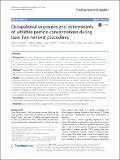| dc.contributor.author | Eshleman, Emily J. | en_US |
| dc.contributor.author | LeBlanc, Mallory | en_US |
| dc.contributor.author | Rokoff, Lisa B. | en_US |
| dc.contributor.author | Xu, Yinyin | en_US |
| dc.contributor.author | Hu, Rui | en_US |
| dc.contributor.author | Lee, Kachiu | en_US |
| dc.contributor.author | Chuang, Gary S. | en_US |
| dc.contributor.author | Adamkiewicz, Gary | en_US |
| dc.contributor.author | Hart, Jaime E. | en_US |
| dc.date.accessioned | 2017-04-06T03:22:17Z | |
| dc.date.issued | 2017 | en_US |
| dc.identifier.citation | Eshleman, Emily J., Mallory LeBlanc, Lisa B. Rokoff, Yinyin Xu, Rui Hu, Kachiu Lee, Gary S. Chuang, Gary Adamkiewicz, and Jaime E. Hart. 2017. “Occupational exposures and determinants of ultrafine particle concentrations during laser hair removal procedures.” Environmental Health 16 (1): 30. doi:10.1186/s12940-017-0239-z. http://dx.doi.org/10.1186/s12940-017-0239-z. | en |
| dc.identifier.issn | | en |
| dc.identifier.uri | http://nrs.harvard.edu/urn-3:HUL.InstRepos:32072206 | |
| dc.description.abstract | Background: Occupational exposures to ultrafine particles in the plume generated during laser hair removal procedures, the most commonly performed light based cosmetic procedure, have not been thoroughly characterized. Acute and chronic exposures to ambient ultrafine particles have been associated with a number of negative respiratory and cardiovascular health effects. Thus, the aim of this study was to measure airborne concentrations of particles in a diameter size range of 10 nm to 1 μm in procedure rooms during laser hair removal procedures. Methods: TSI Model 3007 Condensation Particle Counters were used to quantify the particle count concentrations in the waiting and procedure rooms of a dermatology office. Particle concentrations were sampled before, during, and after laser hair removal procedures, and characteristics of each procedure were noted by the performing dermatologist. Results: Twelve procedures were sampled over 4 days. Mean ultrafine particle concentrations in the waiting and procedure rooms were 14,957.4 particles/cm3 and 22,916.8 particles/cm3 (p < 0.0001), respectively. Compared to background ultrafine particle concentrations before the procedure, the mean concentration in the procedure room was 2.89 times greater during the procedure (p = 0.009) and 2.09 times greater after the procedure (p = 0.007). Duration of procedure (p = 0.006), body part (p = 0.013), and the use of pre-laser lotion/type of laser (p = 0.039), were the most important predictors of ultrafine particle concentrations. Use of a smoke evacuator (a recommended form of local exhaust ventilation) positioned at 30.5 cm from the source, as opposed to the recommended 1–2 in., lowered particle concentrations, but was not a statistically significant predictor (p = 0.49). Conclusions: Laser hair removal procedures can generate high exposures to ultrafine particles for dermatologists and other individuals performing laser hair removal, with exposure varying based on multiple determinants. | en |
| dc.language.iso | en_US | en |
| dc.publisher | BioMed Central | en |
| dc.relation.isversionof | doi:10.1186/s12940-017-0239-z | en |
| dc.relation.hasversion | http://www.ncbi.nlm.nih.gov/pmc/articles/PMC5372340/pdf/ | en |
| dash.license | LAA | en_US |
| dc.subject | Laser | en |
| dc.subject | Ultrafine particles | en |
| dc.subject | Surgical plume | en |
| dc.subject | Laser hair removal | en |
| dc.subject | Occupational exposures | en |
| dc.title | Occupational exposures and determinants of ultrafine particle concentrations during laser hair removal procedures | en |
| dc.type | Journal Article | en_US |
| dc.description.version | Version of Record | en |
| dc.relation.journal | Environmental Health | en |
| dash.depositing.author | Adamkiewicz, Gary | en_US |
| dc.date.available | 2017-04-06T03:22:17Z | |
| dash.hope.year | 2017 | en_US |
| dc.identifier.doi | 10.1186/s12940-017-0239-z | * |
| dash.contributor.affiliated | Hart, Jaime | |
| dash.contributor.affiliated | Adamkiewicz, Gary | |


